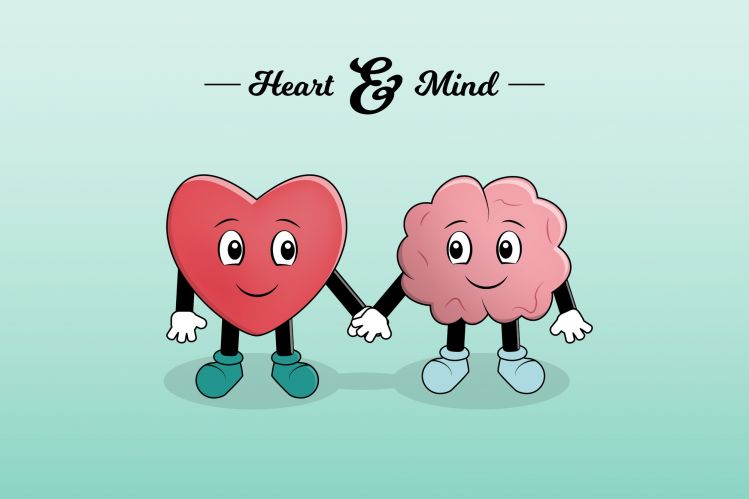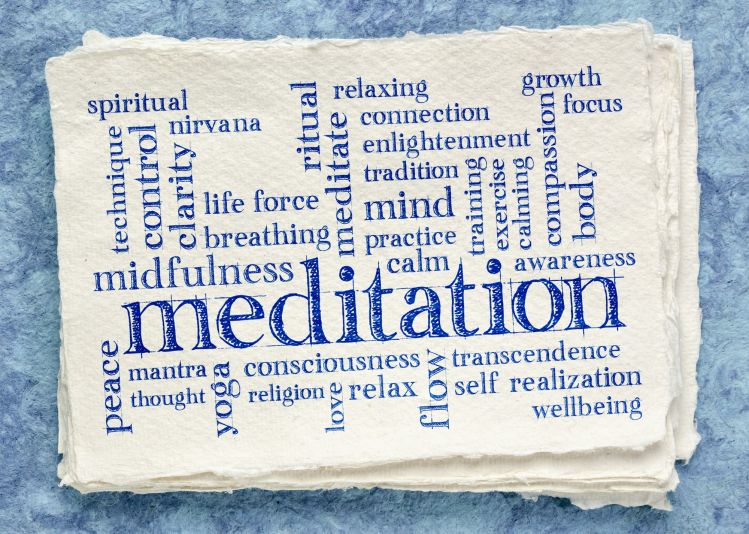Meditation 101: Benefits and Meditation Guide
Lesson 5
Introduction
Over the last several years, the practice of mindful meditation has risen in popularity. It has started to gain mainstream acceptance as a preventative healing method and one of the most studied alternative ways of therapy. In addition, it has been proven that mindful meditation has a wide range of benefits regarding mental, emotional, physical, and spiritual well-being.
More and more healthcare professionals are recommending meditation to deal with depression, stress, and anxiety. Practising meditation will enable you to get into a state of deep relaxation within minutes. This makes it possible for the stress-causing hormone cortisol levels to drop, resulting in balancing our neurotransmitters, including the happiness hormone serotonin.
Science has discovered that conditions of depression, stress, and anxiety have a way of altering the brain’s structure. This can result in one’s thoughts and mind focusing more on the negative things that have happened in the past or are more likely to occur in the future.
By engaging in meditation, you can change your awareness to the extent that you can better view things more transparently, focusing on the present. By focusing on the present, you can gain more clarity and improved health for your body and mind. Practising meditation has the potential of transforming your life, as well as the perception of the world.

The techniques used help you find relief from everyday life stress and depression and attain clarity of mind with the continued improvement of the benefits as you engage further with meditation. So whether you’re a beginner with no apparent purpose for practising meditation or dealing with a specific condition that can only be relieved through meditation, you will continue to realise the benefits as you continue to embrace the practice of meditation as a habit.
Meditation is a practice aimed at training the mind. This is achieved by introducing a level of consciousness that enables the brain to engage deeply in peaceful thoughts. Whether it’s ruminating over the past or worrying about the future, the human mind does everything it can to avoid being present. The process involves using techniques and practices that enhance concentration, clarity, emotional positivity, and calm to transform the mind and enable you to see the true meaning of things.
When you practice meditation, you can learn and identify the habits and patterns of the mind. It can also enable you to cultivate new and positive ways of being. When done regularly, meditation has the potential of transforming your mind into being more energised, peaceful, and calm. Meditation is a simple process that involves observing the mentality rather than trying to control it. It allows you to get into a state where your thoughts start to flow freely without judgment. With regular practice, you slowly begin to become more aware as fewer thoughts pass through your mind.
Meditation can also be defined as a technique that helps in resting the mind to attain a state of consciousness different from the waking state. This means getting a deeper insight into who you indeed are while experiencing the centre of consciousness within us. While various religions identify with meditation, it is a science and not a religious ritual. The meditation process follows a given order with defined principles and leads to results that can be supported, making it a science and not an act of faith.
Benefits of Meditation
The practice of meditation originated in India between 5,000 and 3,000 BCE. Archaeologists, while at the Indus valley, discovered evidence of meditation. The images depicted people sitting in what could be recognised as meditation postures. They also discovered descriptions regarding meditation techniques that were found in the Indian scriptures the Tantras that date back to 3,000 years ago.
Over the centuries, the practice was adopted by some of India’s neighbouring countries, where it formed part of the religions. It then spread to other parts of the region and is now practised throughout the world. While the practice of meditation varies depending on the cultural and religious influences, it has been identified as a significant cornerstone of spiritual development.
The various aspects of meditation, including the mystical elements, has been incorporated by almost all the major religions.
One doesn’t have to follow the religious traditions to enjoy the benefits of meditation, making it a universal act that anyone in the world can practice.

The practise of meditation continues to rise in popularity due to numerous studies that have been conducted to reveal the various benefits. Meditation should be practised regularly as a way to train the mind and improve concentration, focus, and control of your thoughts. Numerous benefits have been associated with the practice of meditation.
Along with the clarity of mind, meditation can help improve your sleeping patterns, provide you with relief from depression, stress, and anxiety, enhance your levels of self-discipline, enhance your levels of positive mental attitude, as well as improve your mood. There are many other valuable benefits that can be experienced through the practice of meditation.
Just as in the same way that meditation alters the mind, it also changes the structure and functioning of the brain, resulting in various mental benefits. There are numerous benefits of meditation, added to the fact that it can be done free from the comfort of your own home, which makes it extremely useful. Meditation provides spiritual, physical, mental, and emotional benefits. Here are some of the benefits you can gain from practising meditation daily.
Mental Benefits
There are numerous mental benefits that are associated with regular meditation. Here are just a few of the mental benefits that you can gain by practising mindfulness through meditation on a regular basis. Reduces Stress, Anxiety, and Depression.
One of the main reasons people engage in meditation is finding relief from stress, depression, and anxiety. They have determined that meditation helps to reduce stress levels and depression, both mentally and physically. When the body experiences a sudden threat or increased stress, it immediately triggers the fight or flight response.

This leads to a sudden rush of adrenaline due to the release of epinephrine hormones. These hormones cause your pulse rate and blood pressure to rise, and increases blood flow to your muscles, and results in faster breathing. The relaxation process that occurs during meditation helps relieve stress and the symptoms associated with stress. After just eight weeks of consistent meditation practise, the benefits you gain are enormous and may even last for years.
Mindful meditation, when combined with breathing techniques, has the potential for dramatically reducing or, in some cases, eliminating cases of stress, anxiety, and depression that occur when the daily pressures of life and other unpleasant situations become more intense than you can cope with. Stress and depression don’t happen because the problem at hand is valid or not. It is influenced more by how you respond to the situation.
Practising meditation gives you the opportunity to analyse the stressors and determine if they are valid or not. Meditation creates a level of awareness where you are able to see things from another perspective. Training the mind through various meditation techniques will increase the mental resources used to help you address stress and depression. With consistent meditation practice, you can improve the clarity, focus, and calm in your mind, which leads to a reduction of stress. All required to be free from stress and depression are practising meditation for about 10 minutes a day.

Recovery from Addiction
It has been proven that regular meditation practice can be extremely useful in helping with recovery from addiction. Meditation helps change how the brain can process information. This helps to enable addicts to evaluate cases of addiction and allows them to act appropriately without the use of drugs. Mindful meditation helps to induce a state of relaxation, giving addicts the ability to monitor their breathing as they stay calm. Being in this kind of state helps them reduce negative feelings and the cravings that cause addicts to seek out the drugs or substances they are addicted to.
Anyone can learn the process of meditation for recovery from addiction. Engaging in meditation helps those recovering from addiction to clearly observe their desires and thoughts without being compelled to act on them. It allows them to understand that they aren’t responsible for the images that come into their minds but are responsible for ultimately reacting to those thoughts. With the clarity of mind that meditation brings, addicts can make healthier choices that help the recovery process.
During the early stages of the recovery process, addicts often experience severe mood swings. By engaging in meditation, their mind is forced to focus on one thing, such as breathing, a mantra, or an object that can help them to focus on overcoming addiction.
Pain

There have been various clinical settings that have used meditation to help patients that deal with chronic pain. Numerous studies have discovered that if you can focus and calm your mind and body, you are equally capable of controlling pain.
When it comes to relieving pain or tension in the body, the practice of pranayama can also be a powerful healing tool.
The practise of meditation makes it possible to face muscle tension, irritability and sweating often associated with chronic pain. When you practice mindfulness through meditation, you can come to terms with the pain that you are experiencing instead of running away from it or masking it with medication.
Increase Happiness

You can significantly increase your level of happiness and good feelings by engaging in mindfulness through meditation. Participating in regular practice will allow your brain to better focus on positive emotions. Just like when you train your muscles and exercise for better performance, you can also work on your feelings of happiness.
Engaging in meditation regularly increases your feelings of joy and happiness.
Mindful meditation helps to improve the psychological function of the brain, leading to the release of the hormones responsible for feelings of joy. Health Benefits The health benefits that are associated with meditation are pretty diverse.
Some have even been proven scientifically to be highly effective. Here are some of the health benefits that you can experience when you engage in meditation regularly. Increased Immunity: It has been proven that when you get into a relaxed state through meditation, it helps boost immunity in patients recovering from cancer.
With the continued practice of muscular relaxation, you can reduce the risk of cancer coming back. It also helps boost the natural killer cells that are common with the elderly, giving them a higher level of resistance to viruses.
Emotional Balance
Your emotional balance entails being free from the neurotic behaviour that leads to a troubled ego. If you want to remain focused and find mental clarity, you must achieve emotional balance. Meditation helps to cure cases of emotional imbalance, leading to the release of soaked memories, which then results in mental freedom. Your reaction and responses to issues will no longer be influenced by the emotional burden when you start to practice meditation.
It will allow you to view things in their true nature. Lowers Blood Pressure Practising meditation has been shown to help with reducing blood pressure levels. It also helps to make the body less responsive to the hormones that cause stress.
Meditation provides similar results that can be experienced when taking blood pressure medication. Engaging in meditation will help to significantly reduce stress levels, which enables your body’s systems to normalise, resulting in overall improved health.
Improved Cardiovascular Health

When you are in a meditative, relaxed state, the release of nitric oxide by the brain increases, this causes the blood vessels to open up, resulting in a drop in blood pressure. Nitric oxide is responsible for improving the function of the immune system, regulating blood pressure levels, improving the role of the central nervous system, behavioural activities, and improved memory.
Practising meditation alters the physiological functioning of the body. This positively impacts some parts of the brain, which results in experiencing deep levels of relaxation and calmness. This deep level of relaxation results in the heart pumping blood slowly and steadily, delivering sufficient oxygen levels throughout the body.
Spiritual Benefits
Many religions have incorporated meditation into their religious practices. Meditation is an essential cornerstone of spiritual development. However, because meditation is more like a science, anyone can practice it, regardless of their faith or religion. There are numerous spiritual benefits that you can experience through the practice of meditation.
Increased Self-Awareness
One of the significant spiritual benefits of practising meditation is self-awareness. Self-awareness involves going deep within yourself through mindful meditation, connecting with your inner self.
Self-awareness forms the basis of meditation and entails identifying with the very core of being, being aware of the present moment, how you react to things, the subtle issues of the mind, and the behaviours and habits.
Once you are aware of this, you will learn how to keenly monitor how you respond to situations from a disconnected perspective.
Practising meditation allows you to rise above the domain of your senses to connect deeper with the spirit. Operating at this level supersedes the emotional level. It provides you with the capability to usher yourself into a state of high revelation and insight, which isn’t attainable at the emotional level.
Types of Meditation
Meditation has become a universal practice giving people a way to cultivate an inner sense of peace and happiness. Numerous religions practice meditation, although they practice it differently and for various reasons. While some practice it as a way to connect to God and for being able to listen to God more clearly, others use meditation as a way to enhance their levels of awareness. Whether you are practising meditation to overcome depression and stress, find a way to heal from chronic disease or self-awareness, it is vital to know the type of meditation that best suits your needs
Anyone can practice meditation anywhere they are comfortable. The practice leads you to experience enhanced levels of consciousness and self-awareness, leading to a host of benefits discussed previously. Learning how to practice meditation effectively can help you avoid stress, depression, anxiety, and possible death from stress-related diseases.
Regularly practising meditation allows you to get into a state of mind where you can think with clarity, without the negative perceptions that often influence your thinking. There are no specific ways to meditate, and some practices can be done while moving, engaging in various yoga poses, or simply sitting quietly. You must find a meditation practice that best suits your needs. You will also want to consider the kind of meditation that complements your personality to provide you with enhanced comfort.
Here are the different kinds of meditation that you can practice.
Each of these meditation types requires some skill and knowledge to practice. If you are not well-versed with meditation practice, it isn’t advisable to try all of them. Like the transcendental meditation, some may marshal you into levels of consciousness that, as a beginner, you may not be prepared to process. As a beginner, it is recommended that you start with mindfulness meditation, which is simple to try out.
Mindfulness Meditation
Mindfulness meditation has its origins in Buddhist teachings and is one of the most popular forms of meditation. It involves regulating the breath. This leads to the activation of the parasympathetic nervous system. The process focuses on paying attention to your breathing and the thoughts that pass through your mind. Your attention should be allowed to flow freely without attaching any judgment.
As you begin to practice and observe your feelings, you will identify the complex patterns. Mindfulness meditation is perfect for those who suffer from depression, anxiety, and stress as it enhances your awareness of the present moment, resulting in increased concentration levels. In mindfulness meditation, the breath can be used as the object for enhanced concentration.
It requires you to become more focused on the rhythm and sensation of your fundamental life force.
As you focus on your breath, it enables you to begin to observe feelings, thoughts as they pass through your mind, and bodily sensations.
If you don’t have someone that can guide you through the process, mindfulness meditation is the ideal practice to begin because you can practice it privately from wherever you feel comfortable. Various studies have proved that engaging in mindfulness meditation regularly for at least eight weeks has the potential of providing you with more prolonged periods of happiness and peace.
Focused meditation
Focused attention meditation, also called concentrative meditation, is when your attention is directed to a single awareness—focusing one’s attention on a given object, sound, or any other stimulus. It is also different from contemplative meditation in that any intelligent engagement with the object of focus should be avoided — the point is the concentration itself.
It entails having to enter into a concentrated focus through the use of the senses and can differ from mindfulness in that the field of awareness is narrow. For example, you can either choose to focus on your breath, staring at a lit candle, count beads, or listen to sound like a gong.
The focusing should be intense, even as you stay in the moment. Focused meditation may seem to be easy, but for those who are just beginning on their path, intently focusing your attention for a period can prove to be a challenge.
If your mind is used to wandering, you have to take control and practice as you continue to focus on the object. If you find that you are struggling with concentration and focus issues, then this is the best kind of meditation that you can practice guaranteeing your desired results.
Spiritual Meditation

Spiritual meditation is geared toward enhancing an awakening process and most commonly practised with the Eastern religions Hinduism and Daoism. Spiritual meditation is aimed at creating stillness and a deeper connection with God or the life force. It is believed that most of the suffering comes from the wrong belief that we are separate from God.
Enlightenment is a state of awakened understanding. It can be described as the transcendence of suffering and desire in order to obtain spiritual liberation (moksha). To be enlightened is to be freed from the tyranny of the mind and to experience deep spiritual peace, presence and wholeness.
The state of enlightenment is significant in Hindu, Buddhist and yogic philosophy. According to the teachings of yoga, enlightenment is the goal of all meditation and yogic practices - physical, mental or spiritual.
It is thought that by engaging in spiritual meditation, you can make a deeper connection, resulting in deeper peace within yourself.
Spiritual meditation involves using various elements like frankincense, myrrh, sandalwood, cedar, and other forms of essential oils. The components carry some religious significance and are thought to heighten the spiritual experiences during the process.

This type of meditation can be practised with the help of a guide. It is suitable for those seeking spiritual enlightenment, higher levels of consciousness, and increased levels of awareness. It is also ideal if you are seeking insight and guidance regarding an issue or spiritual growth.
Movement Meditation
You don’t have to practice meditation in the seated lotus position. It is possible to enjoy the practice of meditation as you move around. Movement meditation can be done while walking in the forest, gardening, taking various poses, or engaging in various forms of motion.
Many forms of the physical practice of yoga are, in fact, moving meditation. The simple Sun Salutation vinyasa with the mind and breath synchronized creates a meditative state with movement.
Moving meditation can also be an extension of traditional meditation, something called a slow hand moving meditation.
In movement meditation, you engage in movements while also being aware of the body’s movements. You can still feel the smell of the air, the tensing of your legs as they move, and the sound of your feet as they step on the ground.
Movement meditation is suitable for those who find joy in movement and grow restless when they sit still for too long.

While flowing movement from one yoga asana to another can be moving meditation, the practice of qigong, tai chi and aikido also involve moving meditation, as does walking a labyrinth and Sufi whirling. Even dance movements can form the foundation for moving meditation.
Movement meditation provides your body with an outlet for your energy while stimulating the circulation of blood and energy into the body. Movement meditation also enhances spiritual exploration and has a way of restoring equilibrium to the mind.
When your mind is in a state of restlessness as a result of stress or depression, movement meditation can be an ideal way to address both the physical body and mind.
Transcendental Meditation

Transcendental meditation is practised for the primary purpose of attaining peace and wellness. It is a prevalent kind of meditation and entails avoiding distracting thoughts as one engages in breathing. This leads to the realisation of a relaxed state of awareness.
Transcendental meditation originates from the Indian Vedic tradition, which entails having a person sit in a comfortable posture with their eyes closed while silently repeating a specific mantra. Transcendental meditation is a type of meditation that uses mantras to transcend normal thought processes.
The purpose of using a mantra is to get the mind focused on various bodily sensations while enhancing concentration. While you are in this meditative state, your thoughts will shift as they relax. This leads to you being able to transcend the physical senses. As your awareness becomes more enhanced, you are able to connect to your deeper self and pure consciousness better.
This is extremely empowering and energetic. It allows you to get to realise a deep level of perfect stillness without any mental boundaries. While you are in this kind of state of consciousness, you can experience rest, peace, and stability along with a whole host of other benefits. This type of meditation is suitable if you are undergoing chronic pain, chronic depression, high blood pressure, and other health conditions.
Transcendental meditation is the most scientifically studied practice, with various reports outlining its effectiveness.
Transcendental meditation can either be practised by oneself or with the help of a guide, especially if you are new to meditation. Mantra Meditation This is another type of meditation that has become popular and is closely associated with some religious teachings.
Mantra meditation is usually practised within Hindu and Buddhist traditions. It involves the use of repetitive words, sound, or phrases and is practised with the intent of clearing the mind. The use of a mantra as a way to meditate is also every day in the secular world.
Famous words like “aum,” affirmations and different phrases are repeatedly used until your consciousness shifts. You can either speak the mantra loudly or softly, whichever way you find to be most comfortable. Many mantras can be interpreted, while there are those where their values are driven by the quality of the sound that is produced when the mantra is spoken. You can also listen to a mantra rather than reciting it, and it can be expressed at high speed or slow speed. You can even match the mantra to certain bodily sensations, breathing, or visualisations.
When it comes to mantra’s, reciting a unique word is not as important as the vibrations that are generated through the sound. Sound vibrations can cause the cells in the body to vibrate at a particular frequency. It is that frequency that has the potential to restructure the brain, which results in higher levels of awareness.
Getting Started Guide
Now that you know more about the different types of meditation, you can choose the type you want to practice depending on the one that best suits your needs. If you are having problems with stress and depression, then mindfulness meditation is one of the types that you should consider starting. However, others can still help you find relief from stress and depression. While meditation might seem like a simple practice, in reality, it requires a lot of discipline and diligence to realise the many benefits.
To have effective results with your meditation practice, different things need to be put in place. As a newcomer just starting out with meditation, you need to know how to prepare for the process, which can help ensure that the process goes well.
It is essential to take the time and prepare for your meditation session just like you would when planning for other activities. Some of the things you need to have before starting on your meditation journey include motivation, goals, expectations, posture, diligence, and eliminating distractions.
Firing Up Your Motivation
When you first begin the meditation process, you need to take the time to remind yourself why you’ve chosen to meditate. Your purpose should be clear, so you know whether your practise is successful or not.
For example, your goal for starting meditation could be to gain more peace, joy, and happiness, improve your mental skills, or even achieve some awakening level. Whatever your purpose for meditating, it needs to be clear as it will help make you more motivated to find success. Having the motivation will help you to deal with feelings of restlessness or any form of resistance that may arise during the process.
Set Reasonable Goals
Goals will help give you direction, and setting realistic goals is essential if you are to be successful in your meditation practice. You need to ask yourself what you want to accomplish with each meditation session. Start with simple goals, like trying to stay patient as the mind wanders or as you get sleepy.
Next, you can think of some of the common challenges that you face during your meditation, like getting distracted with simple things or yielding to distracting thoughts. Then, you can set a reasonable goal that will enable you to overcome the given challenges. As you set goals, you need to be aware of your expectations. Once you realise your expectation, then you can diligently work toward accomplishing them.
The expectations, however, should not be too ambitious, such as believing that you will be able to achieve a raised level of consciousness with just a few sessions. You have to understand that you may practice for several weeks without seeing any tangible transformation.
So, you need to set reasonable goals so that you aren’t discouraged when practising. As you begin your meditation practise, you may lack the stability that will enable you to concentrate or attain mindfulness. However, you need to know that it is normal and that your level of attention will gradually improve as you continue with the process. Regardless of how you practice meditation, you should know that there isn’t a specific way to follow, and there is no such thing as a bad meditation.
Meditation Strength
The results you desire will only be realised when you are diligent with the practice, making sure you get fully committed to diligence. This means that you are fully involved in the training and not wasting your time daydreaming. When you lack perseverance, you will lose too much of your time thinking about issues that don’t interest you instead of focusing on the problems you are trying to solve through mediation.
When you lack diligence, you may also find that you begin judging yourself for the quality of your meditation practice. This can lead to you starting to resist your practice, engaging in procrastination, and feeling a sense of doubt.
You must resolve your heart to diligently practising meditation for the entire process, regardless of how the process turns out. Identify Potential Distractions As you take the time to prepare for each meditation session, you need to perform a quick inventory to identify some things that can cause you to become distracted.
Check if your mind might be preoccupied with thoughts about the things that may not have gone well for you during the day. You also need to check to see if your mind is focused on worries and stressful thoughts about the future.
To be successful, you need to clear your mind of any form of anxiety or worry, acknowledge the feelings that might be going through your mind and the emotions you may be experiencing. It would be best if you then worked to resolve them. You can even set a clear intention that will enable you to rise above the distractions to stay focused on the process. To adequately prepare for your meditation practice, you will need to gather the following items before you begin.
A Timer

When you first start your meditation practice, you will need to choose a convenient time to practice. You need to select a time that is most convenient for you, as meditation is supposed to be a time of relaxation.
Therefore, you should choose a time when you feel the freest and when you won’t have any distractions. You can select a time that centres around hours of transition, such as sunrise and sunset.
These are great times to practice your meditation due to the calm that prevails around these times.
You can use your phone for a timer or download a meditation app to help you with your practice.
A Quiet Place

The place that you chose for your meditation practice should be comfortable and convenient. It would be best if you decided on a site without any distractions. It needs to be a place where you can have some privacy during the meditation session.
Avoid distractions from the television or any other form of noise. The area you choose should also be kept clean and free from clutter. Being in a quiet and peaceful surrounding can make a massive difference in the meditation process.
Choose a Comfortable Posture
The posture you choose for your meditation practice can lead to you feeling more focused and relaxed during the process or could lead to discomfort. The kind of position that you use should be one that you’re comfortable with and one that is ideal for your body type. You need to have proper body alignment and stability of your spine, shoulders, and neck. Maintaining the appropriate alignment is vital for the process and can help in lengthening the time you can meditate.
If you have a problem with your spine and not comfortable, do not insist on it. Most individuals will experience discomfort during their first few experiences with this type of straightening of the back. For most, this will go away after you get used to it. If it is a pain, though, don’t force yourself to do this.
You may be enticed to meditate in a lying down position. Although this position does work, it often causes individuals that are new to meditation to fall asleep.
Meditation Mastery: Breath Control
Breath Control, The key to meditation is breathing, as it is involved in all aspects of the practice.
While breathing is an essential element of life, and the practice of breathing is at the heart of yoga. Practising breath work on its own or synchronising it with yoga postures is what allows people to achieve the mind-body connection that yogis strive for.
Conscious breathing calms the mind and relaxes the body and that's because, breathing can be done both consciously and unconsciously. However, many people don’t know how to engage in breathing consciously to nourish the heart and provide the body with beneficial properties. How we breathe impacts the feelings we get, so participating in shallow and erratic breaths will cause you to feel the same way. On the other hand, engaging in deep and rhythmic breathing can be incredibly satisfying and a great way to live.
First, you must become more aware of your breath and heartbeat. Then, you can work to synchronise your breathing with your pulse to enhance the connection between your heart and mind. When both are connected and working together in harmony, you will be able to get into a place where anything is possible.
Your breath is what creates relaxation as you become more experienced with meditation. Controlled breathing helps to enhance the function of your mind and body. It can also help to lower your blood pressure, improves relaxation and feelings of calm.
Below are some breathing techniques to practice for your health and enhance your relaxation feelings. Equal Breathing This balanced breathing technique is ideal for the body. To begin, take deep breaths, counting to four before exhaling as you count to four. It would be best if you were breathing through your nose as it helps to add some natural resistance to your breathing.
This exercise will help you to reduce stress, calm your nervous system and provide you with increased focus. The activity can be done anytime but works well when done before bed. It is also an ideal exercise for beginners.
Abdominal breathing
This technique can be carried out by placing one hand on the belly and another on your chest. Inhale deeply through the nose, ensuring that your diaphragm inflates with a sufficient amount of air, making it capable of stretching the lungs. Take about six to ten slow breaths a minute for about ten minutes. Practice this every day for about eight weeks.
Alternate Nostril Breathing
This type of breathing technique helps to bring balance and calm while uniting the right and left sides of your brain. To begin with, find a comfortable meditation pose. Hold your right thumb over your right nostril. Take a deep breath through your left nostril, then while at the peak, close the nostril off using your ring finger, then breathe out through your left nostril.

Continue with the same pattern as you breathe through the nostril, using the right thumb to close off the right nostril, breathing out through your left nostril. This breathing technique is suitable to do whenever you need time to energise or focus your mind.
Do not try this technique before going to bed. It shouldn’t be used by beginners but by those who are at the intermediate level of meditation. Skull Shining Breathing This breathing technique helps to brighten your day from the inside out. It starts with engaging in a long, slow inhale that is followed by a quick and forceful exhale that comes from your lower abdomen. Once you are comfortable, you can increase the pace and contraction to one in and out-breath.
The technique can be practised when you first wake up in the morning as it enhances the overall outlook of things. The exercise is abdominal intensive and will help to shake off the old energy you have upon waking while warming up the mind. Progressive relaxation This technique is used to relieve tension in the body. It should be focused on tensing and relaxing the muscles.
Start off focusing on tensing and relaxing your feet and toes, moving upwards to the knees, thighs, and other parts of the body. This technique can be done anywhere you feel comfortable. Guided Visualization This technique should be practised with a therapist or coach. You begin the method by breathing deeply as you focus on images that are positive and pleasant.
These should be used to replace negative thoughts. Guided visualisation isn’t just for realising mindfulness; it also helps with putting you into the right state of mind. You can carry out this exercise anywhere, as long as you are able to close your eyes and let go. You should already have some basic meditation knowledge before trying this technique.
Practical Tips for Successful Meditation
Now that you are aware of what meditation entails and the many benefits you can gain from practising meditation daily, some practical tips can help you get the best out of your meditation practice. As a beginner, the following tips can help you overcome common problems that are related to the mediation process.
Start Small
Numerous studies have shown that beginners who started their practice with meditating for three to five minutes managed to sustain the course and develop it as a habit. As you begin your meditation practice, start by taking at least three deep breaths as you pay attention to the various sensations that you feel throughout your body.
Have a Clear Understanding of the Benefits
Suppose you suffer from anxiety, depression, or stress. In that case, it is important to have a clear understanding of what meditation can do for you. It will help you learn how you can recognise the destructive patterns that you may continue to fall into, like engaging in critical thoughts that trigger the stress, anxiety, and depression symptoms that you are trying to conquer.
Understand the Principles of Meditation When most people start practising meditation, they get to a point where they believe that the goal is to reach a state of consciousness where they can focus without getting distracted. However, the focus shouldn’t be on how not to get distracted; instead, it should be on becoming more aware so that you can recognise when your mind starts to drift.
If you cannot identify your thoughts, it will be impossible to restructure them. You need to develop awareness so that you can clearly identify your thoughts. Another principle that you should be aware of as a beginner is the ability to redirect your attention back to the point of focus whenever you find yourself drifting. This should be done without criticising yourself.
Follow the Path the Works Well for You
Once you become aware of the steps of meditation and the principles that follow, you can choose the meditation path that appeals to you. If you find that walking is an ideal practice because you can concentrate better, you can focus on meditating while walking; practising meditation while walking can also help you eliminate distractions.
You can focus your walking so that the first ten minutes of your meditation is focused on a minute of feeling the sensations in your body, another minute feeling your breath, another minute on what you hear, another on what you see, and one more on the feeling of the air on your skin.
This can be followed by the remaining five minutes being focused on your awareness, where you can freely observe your level of consciousness. You should avoid using your senses and just focus on your consciousness. If you find that your thoughts are starting to drift to the future or the past, then turn back to any of the points of focus from the first five minutes and stabilise your attention to the present moment.
Naturally Boost Good Brain Chemicals
Engage in Regular Practice
Engaging in the practice of meditation regular can be challenging. Still, you will only realise the desired goal if you are committed to the training. Regularly practising meditation will also enable you to become more familiar with the exercise until it becomes a habit.
Fuel Your Body with the Right Foods
The foods you consume before starting your practice can significantly impact your overall health and well-being. Foods help nourish the body and affect the level of awareness and quietness you achieve during your training. The type of food that you eat can also be why you might find it challenging to engage in meditation.
Eating certain foods before engaging in meditation may cause you to lack concentration or become sleepy during the process. It is recommended that you wait at least two hours after eating before you begin your meditation practice. Here are some of the healthy foods that you should eat before starting a meditation session.
Fresh Fruits

Fresh fruits are ideal for eating before practising meditation. Fruits are healthy and help you produce the glucose you need to improve your concentration and enhance your overall well-being.
Dark Chocolate

The flavonoids in dark chocolate help promote blood flow to the brain, which can help to improve your memory, focus, and learning. To avoid too many calories and fat intake, you should only consume a couple of pieces at a time.
Green Smoothie

The leafy green vegetables that go into a green smoothie are loaded with antioxidants that help boost your brainpower. To bring a sweeter taste to the smoothie, consider adding fresh fruit. To make it even more powerful, consider adding coconut oil, avocados, and flaxseed. Almonds A handful of almonds contain the necessary nutrients that are needed to reduce hunger while boosting energy.
Consuming a handful of almonds before your meditation session can be highly beneficial for your practice.
Water

To help wake up your brain, you should consume a glass of water before beginning your meditation practice. Along with helping to wake your mind, it also works to get your body rehydrated to avoid getting sleepy during your session.
Foods to Avoid Before Meditation Just like some foods will benefit your meditation practice if consumed shortly before a session, and you will want to avoid foods that you will want to avoid because of the detrimental effect they can have on your training.
Caffeinated Drinks

The intake of drinks and foods like tea, caffeine, and soda in high amounts, should be avoided, as the stimulant in these drinks can make it difficult to keep your mind calm and can even hinder you from getting into a more profound meditative state.
Simple Carbohydrates

Consuming simple carbohydrates like foods and beverages with high sugar content should be avoided at all costs. These can all lead to a spike in your blood sugar levels, which, after a short time will cause you to crash, making you feel drowsy and sluggish.
Meditating when you are tired may not lead to the realisation of your desired goals. Heavy Meals Avoid eating foods that are rich in sugar, fat, and starch, as well as foods that contain creamy sauces and cheese. Your body requires sufficient energy to carry out the digestion of heavy meals, which may lead to you feeling sleepy during meditation.
As you plan for your meditation practice, take the time to consider the types of foods that you eat so that your meditation practice will flow smoothly, giving you the best chance of reaching your desired results.
Conclusion
Meditation is a technique that is very effective for self-discovery. It has been proven to help with overcoming many medical conditions, including stress, anxiety, and depression. Whether you are a beginner who is just starting out with the meditation process or you are well versed in practice, there are techniques that can benefit you greatly when practised on a regular basis.
Nothing is worth the time spent in meditation, especially if it has the potential to enable you to overcome the stress, depression, and anxiety in your life to get to a place of awareness—a place where clarity of mind and peacefulness is usual.
Meditation is the key to releasing you from the fight or flight responses that have been ingrained in us for centuries and bringing you true peace at the moment, regardless of what is happening around you. Make the best use of the information in this guide and start practising the different meditation techniques to find a higher awareness and peace in your life.
Unless you are a true beginner, you can try out other forms of meditation that expose you to excellent dimensions of existence. Use meditation to continue to improve your life and overall well-being.

















